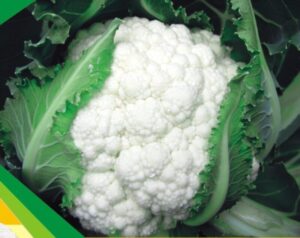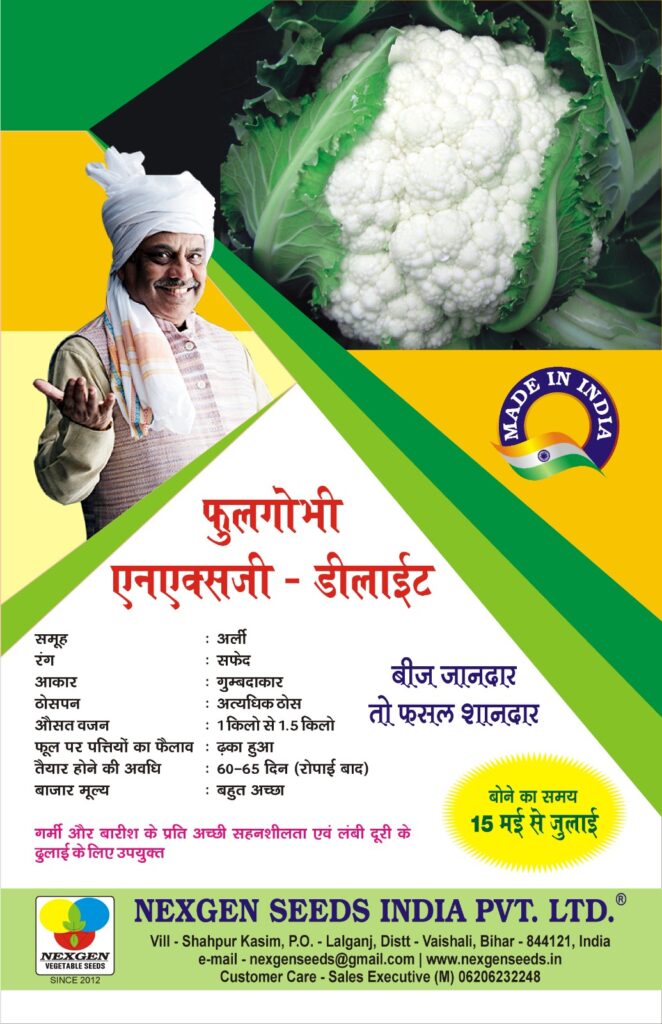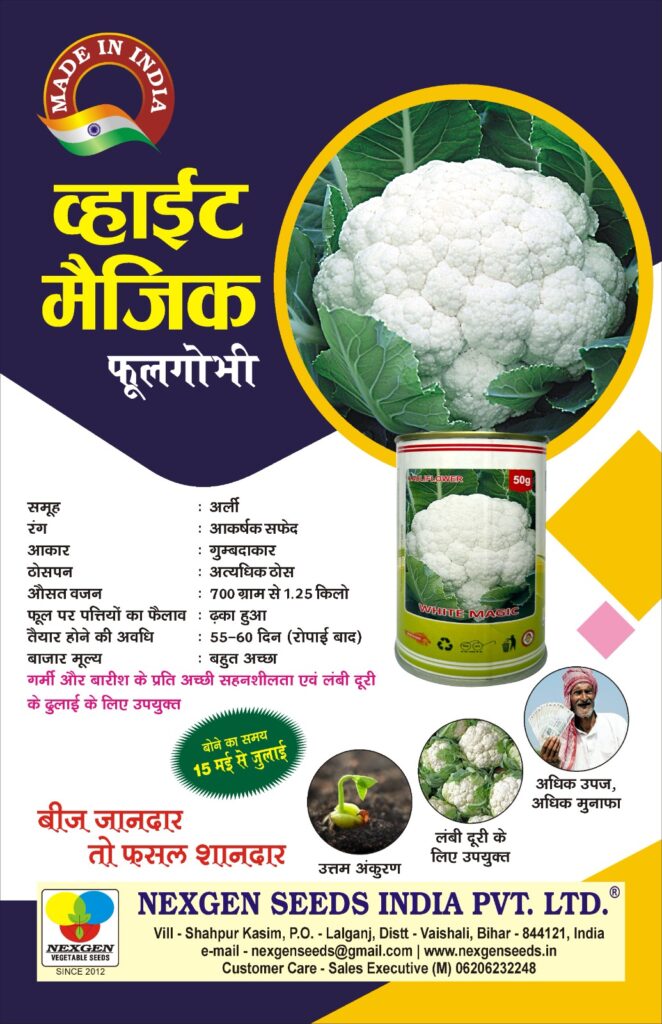
Introduction:
Welcome to the fascinating world of cauliflower exports from India! In recent years, cauliflower has gained significant popularity as a healthy and versatile vegetable worldwide. Among the many countries involved in cauliflower production, India has emerged as a leading exporter, offering high-quality produce to global markets. In this blog, we will delve into the journey of cauliflower cultivation, the export process, and the reasons behind India’s success as a cauliflower exporter. Get ready to explore the vibrant world of cauliflower exports from the incredible land of India.
- The Cauliflower Cultivation Story:
Cauliflower, a member of the cruciferous vegetable family, has been cultivated in India for centuries. The favourable climatic conditions, rich soil, and agricultural expertise have contributed to India’s remarkable cauliflower production. The states of Maharashtra, Uttar Pradesh, and Bihar are known for their extensive cauliflower cultivation, ensuring a steady supply for both domestic consumption and exports.
- Quality Assurance and Export Standards:
When it comes to exporting cauliflower, quality assurance is of paramount importance. Indian cauliflower exporters strictly adhere to international quality standards to ensure that the produce reaches its destination in optimal condition. The cauliflowers are carefully inspected, sorted, and packed to maintain their freshness, texture, and nutritional value throughout the export process.
- Export Process:
The export journey of cauliflower from India involves several steps that ensure a seamless flow of produce from farms to international markets. Let’s take a closer look at the export process of Cauliflower from India:
- Preparing the Crop: Cauliflower cultivation begins with selecting the right variety, sowing seeds, and providing the necessary care, including regular watering, fertilization, and pest control.
- Harvesting: Once the cauliflower heads reach maturity, they are carefully hand-picked to avoid damage. The timing of the harvest is crucial to ensure the best quality produce.
- Sorting and Grading: After harvest, the cauliflowers are sorted based on size, colour, and uniformity. This step ensures that only the finest specimens make it to the export consignments.
- Packaging: The sorted cauliflowers are packed in sturdy, quality packaging materials to protect them during transportation. Packaging also includes labelling with necessary details and compliance with international regulations.
- Transportation: The packaged cauliflowers are transported to airports or seaports using temperature-controlled facilities to maintain their freshness. Air transport is preferred for long-distance exports to ensure minimal transit time.
- Documentation and Customs: Exporters handle the necessary paperwork, including obtaining phytosanitary certificates, complying with international trade regulations, and completing customs formalities.
- Shipping and Logistics: Exporters collaborate with shipping and logistics companies to ensure the timely and efficient transportation of cauliflowers to their final destinations.
- India’s Competitive Edge:
India’s success as a cauliflower exporter can be attributed to several factors:
- Abundant Production: India’s vast agricultural land and favourable climate enable year-round cauliflower cultivation, ensuring a consistent supply for both domestic and international markets.
- Competitive Pricing: India offers competitive pricing due to lower labour and production costs, making it an attractive choice for importers seeking high-quality cauliflower at affordable rates.
- Quality Assurance: Indian cauliflower exporters prioritize quality control measures, ensuring that the produce meets stringent international standards.
- Variety and Availability: India cultivates a wide range of cauliflower varieties, offering importers a diverse selection to meet their specific market demands. This variety and availability give India a competitive edge in the global cauliflower export market.
- Sustainable Practices: Indian cauliflower farmers are increasingly adopting sustainable agricultural practices, such as organic farming and efficient water management. These practices contribute to the production of healthier and environmentally friendly cauliflower, appealing to conscious consumers worldwide.
- Health Benefits of Indian Cauliflower:
Apart from its delicious taste and versatility in culinary applications, cauliflower also boasts numerous health benefits. It is a rich source of vitamins C, K, and B6, as well as folate, fibre, and antioxidants. Regular consumption of cauliflower can promote digestion, boost immunity, support heart health, and even aid in weight management. With its nutritional profile and the assurance of quality, Indian cauliflower has become a sought-after choice for health-conscious consumers worldwide.
- Exploring New Markets:
While India has made great strides in cauliflower exports, there are still untapped markets waiting to be explored. As the demand for healthy and organic produce continues to grow globally, Indian cauliflower exporters can focus on expanding their reach to new markets and establishing strong trade relationships. By promoting the quality and unique attributes of Indian cauliflower, exporters can capture the attention of discerning customers and create a niche for themselves in the international arena.
Conclusion:
The journey of exporting cauliflower from India is a testament to the country’s agricultural prowess, commitment to quality, and adaptability to global market demands. With its favourable climatic conditions, sustainable practices, and a variety of high-quality produce, India has become a significant player in the global cauliflower export market. As consumers around the world increasingly prioritize healthy eating, Indian cauliflower continues to gain popularity for its nutritional value and taste. So, the next time you enjoy a delicious cauliflower dish, remember the incredible journey it took from the farms of India to your plate.
Whether it’s a comforting bowl of cauliflower soup, a flavourful cauliflower curry, or a crispy roasted cauliflower dish, each bite represents the dedication and expertise of Indian cauliflower farmers and exporters.
Read more: Maximizing Yield with Cauliflower Seeds in India
As the demand for cauliflower continues to rise, India remains committed to meeting the needs of international markets. Exporters are constantly exploring innovative packaging solutions that enhance the shelf life of cauliflower, ensuring that it arrives at its destination in optimal condition. Additionally, advancements in transportation and logistics have made it possible to reach even the most remote corners of the globe with fresh, high-quality cauliflower.
Beyond its economic impact, cauliflower exports have also contributed to the socioeconomic development of rural communities in India. The success of cauliflower cultivation has created employment opportunities, improved infrastructure, and uplifted the standard of living for many farmers and their families.
In conclusion, the story of exporting cauliflower from India is one of resilience, quality, and growth. From its humble beginnings as a traditional crop to its position as a leading global exporter, cauliflower has become a symbol of India’s agricultural prowess and commitment to sustainable farming practices. The journey from farm to international market involves careful cultivation, stringent quality control, efficient logistics, and a deep understanding of consumer preferences. So, the next time you savor a delicious cauliflower dish, take a moment to appreciate the incredible journey that brought it to your table, connecting you to the flavors and traditions of India.

Top 20 Challenges Faced by Indian Farmers in Exporting Cauliflower: Solutions for Sustainable Growth
Introduction:
India’s agricultural sector plays a vital role in the country’s economy, and farmers are at the heart of this industry. However, when it comes to exporting cauliflower, they encounter various challenges that hinder their progress. This article highlights the top 20 problems faced by Indian farmers in exporting cauliflower and provides practical solutions to overcome these hurdles.
- Lack of Quality Control:
Issue: Inconsistent quality of cauliflower affects its marketability.
Solution: Farmers should adopt Good Agricultural Practices (GAP) to ensure consistent quality, including proper seed selection, pest and disease management, and post-harvest handling techniques.
- Poor Infrastructure:
Issue: Inadequate cold storage, packaging, and transportation facilities lead to post-harvest losses.
Solution: The government and private sector should invest in improving infrastructure, including establishing more cold storage facilities and upgrading transportation networks.
- Limited Market Access:
Issue: Farmers struggle to find reliable and profitable markets for their cauliflower produce.
Solution: Encouraging partnerships between farmers and exporters, promoting farmer-producer organizations, and establishing direct market linkages can enhance market access for farmers.
- Complex Export Procedures:
Issue: Cumbersome export procedures, including documentation and certification, create barriers for farmers.
Solution: Simplifying export procedures through the utilization of technology and streamlining paperwork can expedite the export process and reduce bureaucracy.
- Lack of Market Intelligence:
Issue: Farmers often lack information about global market trends, demand, and pricing.
Solution: The government and industry associations should provide market intelligence and organize training programs to educate farmers about market dynamics and emerging export opportunities.
- Limited Access to Finance:
Issue: Insufficient access to credit and capital restricts farmers’ ability to invest in infrastructure and technology.
Solution: Financial institutions should offer tailored financial products and schemes to support farmers’ export aspirations, including low-interest loans and credit facilities.
- Inadequate Knowledge about Export Regulations:
Issue: Farmers face challenges in understanding and complying with export regulations and standards.
Solution: Conducting awareness programs, workshops, and training sessions on export regulations can help farmers become familiar with compliance requirements.
- Pest and Disease Management:
Issue: Pests and diseases can damage cauliflower crops, leading to reduced product quality.
Solution: Educating farmers about integrated pest management practices, promoting the use of organic pesticides, and providing timely guidance on disease prevention can help mitigate these challenges.
- Climate Change Impact:
Issue: Changing weather patterns and extreme climatic events affect cauliflower cultivation.
Solution: Encouraging farmers to adopt climate-resilient farming practices, such as crop diversification, water conservation, and precision farming, can help mitigate the effects of climate change.
- Lack of Organic Farming Practices:
Issue: Increasing global demand for organic cauliflower is unmet due to limited adoption of organic farming practices.
Solution: Promoting organic farming techniques through training programs, providing incentives, and supporting organic certification processes can encourage farmers to cultivate organic cauliflower.
- Price Fluctuations:
Issue: Farmers face price volatility, impacting their profitability.
Solution: Establishing farmer-producer cooperatives, exploring futures trading options, and creating price stabilization mechanisms can help farmers manage price fluctuations and secure better returns.
- Lack of Marketing Skills:
Issue: Farmers often lack marketing skills to promote their cauliflower effectively.
Solution: Providing training on marketing techniques, branding, and packaging can empower farmers to market their products.
- Lack of Export Packaging Standards:
Issue: Inconsistent and inadequate packaging standards hinder the export of cauliflower.
Solution: Developing and implementing standardized packaging guidelines for cauliflower exports can enhance product presentation, shelf life, and market acceptance.
- Limited Access to Technology:
Issue: Many farmers lack access to modern agricultural technologies and practices.
Solution: Government initiatives and collaborations with technology providers can ensure the dissemination of advanced farming techniques, such as precision agriculture, efficient irrigation systems, and mechanization, to improve productivity and quality.
- Inefficient Supply Chain Management:
Issue: Inefficient supply chains result in delays and quality deterioration during transportation.
Solution: Strengthening supply chain management through better coordination, implementing cold chain logistics, and promoting efficient handling practices can minimize post-harvest losses and maintain cauliflower quality.
- Lack of Quality Certification:
Issue: The absence of recognized quality certifications hampers cauliflower exports.
Solution: Encouraging farmers to obtain certifications such as Global Good Agricultural Practices (GlobalGAP) or Organic Certification can enhance the credibility and marketability of Indian cauliflower.
- Limited Government Support:
Issue: Insufficient government support in terms of subsidies, infrastructure development, and export promotion.
Solution: Advocating for increased government support, including financial incentives, infrastructure development, and export-oriented policies, can create a conducive environment for farmers to thrive in the export market.
- Price Negotiation Challenges:
Issue: Farmers face difficulty in negotiating fair prices with intermediaries and exporters.
Solution: Strengthening farmer-producer organizations and promoting direct marketing platforms can empower farmers to negotiate better prices and eliminate middlemen.
- Lack of Research and Development:
Issue: Limited investment in agricultural research and development impedes innovation and productivity growth.
Solution: Encouraging public-private partnerships, funding research initiatives, and establishing agricultural research centers can drive innovation, develop high-yielding cauliflower varieties, and enhance farming practices.
- Inadequate Market Infrastructure:
Issue: Lack of market infrastructure, including grading, sorting, and auction facilities, hinders farmers’ ability to sell their cauliflower at competitive prices.
Solution: Developing modern market yards equipped with necessary infrastructure, facilitating electronic auction platforms, and establishing quality grading systems can improve market efficiency and ensure fair pricing for farmers.
Conclusion:
By addressing these twenty challenges and implementing the suggested solutions, Indian farmers can overcome the obstacles they face in exporting cauliflower. This would not only improve their livelihoods but also contribute to the growth of India’s agricultural sector. With proper support, infrastructure, and knowledge, farmers can successfully tap into global markets, promoting sustainable agriculture and economic development in the country.

Top 20 frequently asked questions and answers about exporting cauliflower from India:
**1. Q: What is the current status of cauliflower production in India?**
A: India is one of the largest producers of cauliflower in the world. With favorable climatic conditions and extensive cultivation, cauliflower production has been steadily increasing over the years.
**2. Q: What are the export opportunities for cauliflower from India?**
A: There are ample export opportunities for cauliflower from India. Countries like the United States, United Kingdom, Germany, and the Middle East have a high demand for Indian cauliflower due to its quality, taste, and competitive pricing.
**3. Q: What are the key factors to consider before exporting cauliflower?**
A: Some crucial factors to consider include compliance with quality and safety standards, proper packaging and labeling, transportation logistics, market research to identify potential buyers, and understanding import regulations of the target country.
**4. Q: Are there any certifications required for exporting cauliflower from India?**
A: While certifications may vary based on the importing country’s regulations, it is generally advisable to obtain certifications such as Global GAP (Good Agricultural Practices) and Organic Certification to enhance the marketability of Indian cauliflower.
**5. Q: What is the best time to export cauliflower from India?**
A: Cauliflower is primarily a winter crop in India. The best time to export is during the winter season, typically from October to March, when the crop is in abundance and quality is at its peak.
**6. Q: How can one ensure the quality and freshness of cauliflower during export?**
A: To ensure quality and freshness, it is important to harvest cauliflower at the right stage of maturity, maintain proper temperature and humidity during transportation, and use suitable packaging materials such as ventilated crates or cartons.
**7. Q: What are the common packaging options for exported cauliflower?**
A: Common packaging options for exported cauliflower include corrugated fiberboard boxes, wooden crates, or mesh bags. Packaging should be sturdy, protect the produce from damage, and provide proper ventilation to maintain freshness.
**8. Q: What are the transportation options for exporting cauliflower from India?**
A: Cauliflower can be transported via various modes such as refrigerated trucks, air cargo, or sea freight. The choice of transportation depends on factors like destination, volume, budget, and transit time requirements.
**9. Q: Are there any specific labeling requirements for exported cauliflower?**
A: Yes, labeling requirements may vary based on the importing country’s regulations. Generally, labels should include product information, country of origin, batch/lot numbers, weight, and handling instructions.
**10. Q: How can I find potential buyers for Indian cauliflower?**
A: You can find potential buyers by attending international trade fairs, participating in business matchmaking events, utilizing online platforms, reaching out to import/export associations, or engaging with trade promotion organizations.
**11. Q: Are there any restrictions on exporting cauliflower from India?**
A: While cauliflower exports from India are generally unrestricted, it is essential to stay updated on the export policies, phytosanitary requirements, and trade agreements of the target countries to avoid any potential restrictions.
**12. Q: What are the export documentation requirements for cauliflower?**
A: The typical export documentation includes a commercial invoice, packing list, bill of lading/airway bill, phytosanitary certificate, certificate of origin, certificate of analysis (if applicable), and any other specific documents required by the importing country.
**13. Q: How can I ensure compliance with international quality standards?**
A: To ensure compliance with international quality standards, it is important to follow good agricultural practices, implement quality control measures throughout the supply chain, conduct regular inspections, and engage in testing and certification processes.
**14. Q: What are the potential challenges in exporting cauliflower from India?**
A: Some potential challenges include fluctuating market prices, competition from other exporting countries, maintaining product quality during transportation, meeting import regulations of different countries, and managing logistics effectively.
**15. Q: Are there any government incentives or support for cauliflower exporters in India?**
A: Yes, the Indian government offers various incentives and support schemes to promote agricultural exports, including cauliflower. These may include financial assistance, export promotion programs, subsidies, and market development initiatives.
**16. Q: Can small-scale farmers participate in cauliflower exports?**
A: Yes, small-scale farmers can participate in cauliflower exports. They can collaborate with agricultural cooperatives, exporters, or utilize the services of export facilitators to overcome challenges related to logistics, market access, and compliance.
**17. Q: What are the potential benefits of exporting cauliflower from India?**
A: Exporting cauliflower from India can provide several benefits, such as generating foreign exchange earnings, expanding market reach, improving farmers’ income, stimulating the agricultural economy, and showcasing the quality of Indian produce on a global platform.
**18. Q: How can I differentiate my cauliflower in the international market?**
A: To differentiate your cauliflower in the international market, you can focus on factors such as organic or sustainable cultivation practices, unique varieties, superior taste and texture, consistent quality, reliable and timely delivery, and building strong relationships with buyers based on trust and transparency.
**19. Q: Are there any specific market trends or preferences for cauliflower in different countries?**
A: Market trends and preferences for cauliflower may vary across countries. Some may prioritize organic or pesticide-free produce, while others may value specific sizes or colors. Conducting market research and understanding consumer preferences in the destination market is crucial for success.
**20. Q: How can I stay updated with the latest developments in the cauliflower export industry?**
A: Staying updated with the latest developments in the cauliflower export industry can be done through various channels such as industry publications, trade websites, attending seminars and conferences, networking with industry professionals, and actively participating in relevant trade associations or forums.
Remember, the answers provided here are general guidelines and it’s important to conduct thorough research and seek professional advice before engaging in cauliflower export activities from India.
Read more: From Farm to Market: Linking Farmers for Profitable Ventures
